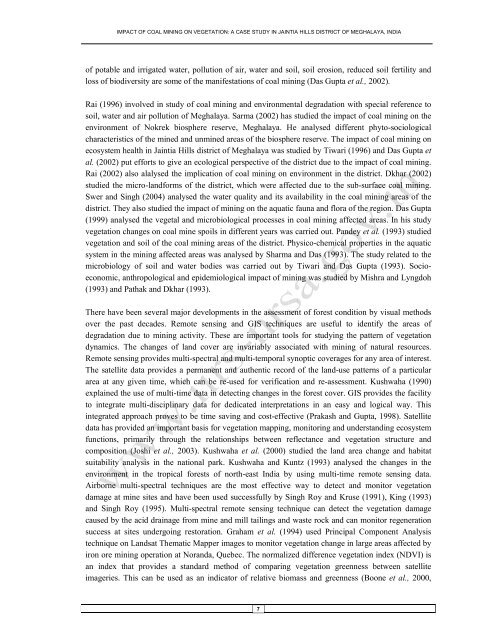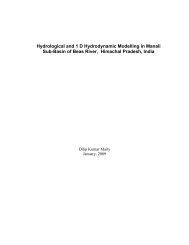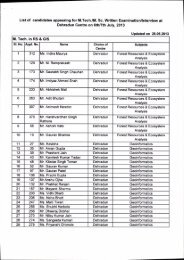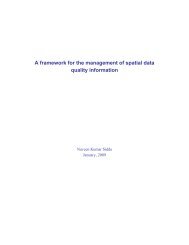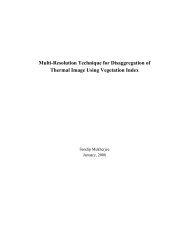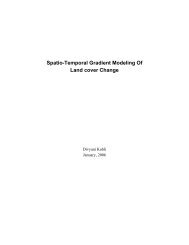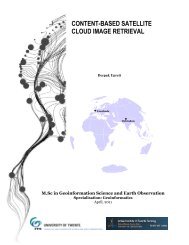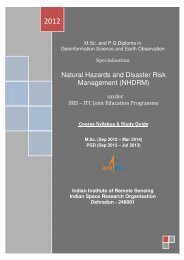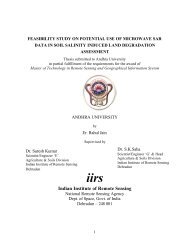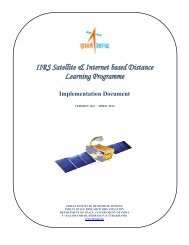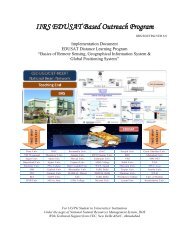Impact of Coal Mining on Vegetation: A Case Study in Jaintia Hills ...
Impact of Coal Mining on Vegetation: A Case Study in Jaintia Hills ...
Impact of Coal Mining on Vegetation: A Case Study in Jaintia Hills ...
Create successful ePaper yourself
Turn your PDF publications into a flip-book with our unique Google optimized e-Paper software.
IMPACT OF COAL MINING ON VEGETATION: A CASE STUDY IN JAINTIA HILLS DISTRICT OF MEGHALAYA, INDIA<str<strong>on</strong>g>of</str<strong>on</strong>g> potable and irrigated water, polluti<strong>on</strong> <str<strong>on</strong>g>of</str<strong>on</strong>g> air, water and soil, soil erosi<strong>on</strong>, reduced soil fertility andloss <str<strong>on</strong>g>of</str<strong>on</strong>g> biodiversity are some <str<strong>on</strong>g>of</str<strong>on</strong>g> the manifestati<strong>on</strong>s <str<strong>on</strong>g>of</str<strong>on</strong>g> coal m<strong>in</strong><strong>in</strong>g (Das Gupta et al., 2002).Rai (1996) <strong>in</strong>volved <strong>in</strong> study <str<strong>on</strong>g>of</str<strong>on</strong>g> coal m<strong>in</strong><strong>in</strong>g and envir<strong>on</strong>mental degradati<strong>on</strong> with special reference tosoil, water and air polluti<strong>on</strong> <str<strong>on</strong>g>of</str<strong>on</strong>g> Meghalaya. Sarma (2002) has studied the impact <str<strong>on</strong>g>of</str<strong>on</strong>g> coal m<strong>in</strong><strong>in</strong>g <strong>on</strong> theenvir<strong>on</strong>ment <str<strong>on</strong>g>of</str<strong>on</strong>g> Nokrek biosphere reserve, Meghalaya. He analysed different phyto-sociologicalcharacteristics <str<strong>on</strong>g>of</str<strong>on</strong>g> the m<strong>in</strong>ed and unm<strong>in</strong>ed areas <str<strong>on</strong>g>of</str<strong>on</strong>g> the biosphere reserve. The impact <str<strong>on</strong>g>of</str<strong>on</strong>g> coal m<strong>in</strong><strong>in</strong>g <strong>on</strong>ecosystem health <strong>in</strong> Ja<strong>in</strong>tia <strong>Hills</strong> district <str<strong>on</strong>g>of</str<strong>on</strong>g> Meghalaya was studied by Tiwari (1996) and Das Gupta etal. (2002) put efforts to give an ecological perspective <str<strong>on</strong>g>of</str<strong>on</strong>g> the district due to the impact <str<strong>on</strong>g>of</str<strong>on</strong>g> coal m<strong>in</strong><strong>in</strong>g.Rai (2002) also alalysed the implicati<strong>on</strong> <str<strong>on</strong>g>of</str<strong>on</strong>g> coal m<strong>in</strong><strong>in</strong>g <strong>on</strong> envir<strong>on</strong>ment <strong>in</strong> the district. Dkhar (2002)studied the micro-landforms <str<strong>on</strong>g>of</str<strong>on</strong>g> the district, which were affected due to the sub-surface coal m<strong>in</strong><strong>in</strong>g.Swer and S<strong>in</strong>gh (2004) analysed the water quality and its availability <strong>in</strong> the coal m<strong>in</strong><strong>in</strong>g areas <str<strong>on</strong>g>of</str<strong>on</strong>g> thedistrict. They also studied the impact <str<strong>on</strong>g>of</str<strong>on</strong>g> m<strong>in</strong><strong>in</strong>g <strong>on</strong> the aquatic fauna and flora <str<strong>on</strong>g>of</str<strong>on</strong>g> the regi<strong>on</strong>. Das Gupta(1999) analysed the vegetal and microbiological processes <strong>in</strong> coal m<strong>in</strong><strong>in</strong>g affected areas. In his studyvegetati<strong>on</strong> changes <strong>on</strong> coal m<strong>in</strong>e spoils <strong>in</strong> different years was carried out. Pandey et al. (1993) studiedvegetati<strong>on</strong> and soil <str<strong>on</strong>g>of</str<strong>on</strong>g> the coal m<strong>in</strong><strong>in</strong>g areas <str<strong>on</strong>g>of</str<strong>on</strong>g> the district. Physico-chemical properties <strong>in</strong> the aquaticsystem <strong>in</strong> the m<strong>in</strong><strong>in</strong>g affected areas was analysed by Sharma and Das (1993). The study related to themicrobiology <str<strong>on</strong>g>of</str<strong>on</strong>g> soil and water bodies was carried out by Tiwari and Das Gupta (1993). Socioec<strong>on</strong>omic,anthropological and epidemiological impact <str<strong>on</strong>g>of</str<strong>on</strong>g> m<strong>in</strong><strong>in</strong>g was studied by Mishra and Lyngdoh(1993) and Pathak and Dkhar (1993).There have been several major developments <strong>in</strong> the assessment <str<strong>on</strong>g>of</str<strong>on</strong>g> forest c<strong>on</strong>diti<strong>on</strong> by visual methodsover the past decades. Remote sens<strong>in</strong>g and GIS techniques are useful to identify the areas <str<strong>on</strong>g>of</str<strong>on</strong>g>degradati<strong>on</strong> due to m<strong>in</strong><strong>in</strong>g activity. These are important tools for study<strong>in</strong>g the pattern <str<strong>on</strong>g>of</str<strong>on</strong>g> vegetati<strong>on</strong>dynamics. The changes <str<strong>on</strong>g>of</str<strong>on</strong>g> land cover are <strong>in</strong>variably associated with m<strong>in</strong><strong>in</strong>g <str<strong>on</strong>g>of</str<strong>on</strong>g> natural resources.Remote sens<strong>in</strong>g provides multi-spectral and multi-temporal synoptic coverages for any area <str<strong>on</strong>g>of</str<strong>on</strong>g> <strong>in</strong>terest.The satellite data provides a permanent and authentic record <str<strong>on</strong>g>of</str<strong>on</strong>g> the land-use patterns <str<strong>on</strong>g>of</str<strong>on</strong>g> a particulararea at any given time, which can be re-used for verificati<strong>on</strong> and re-assessment. Kushwaha (1990)expla<strong>in</strong>ed the use <str<strong>on</strong>g>of</str<strong>on</strong>g> multi-time data <strong>in</strong> detect<strong>in</strong>g changes <strong>in</strong> the forest cover. GIS provides the facilityto <strong>in</strong>tegrate multi-discipl<strong>in</strong>ary data for dedicated <strong>in</strong>terpretati<strong>on</strong>s <strong>in</strong> an easy and logical way. This<strong>in</strong>tegrated approach proves to be time sav<strong>in</strong>g and cost-effective (Prakash and Gupta, 1998). Satellitedata has provided an important basis for vegetati<strong>on</strong> mapp<strong>in</strong>g, m<strong>on</strong>itor<strong>in</strong>g and understand<strong>in</strong>g ecosystemfuncti<strong>on</strong>s, primarily through the relati<strong>on</strong>ships between reflectance and vegetati<strong>on</strong> structure andcompositi<strong>on</strong> (Joshi et al., 2003). Kushwaha et al. (2000) studied the land area change and habitatsuitability analysis <strong>in</strong> the nati<strong>on</strong>al park. Kushwaha and Kuntz (1993) analysed the changes <strong>in</strong> theenvir<strong>on</strong>ment <strong>in</strong> the tropical forests <str<strong>on</strong>g>of</str<strong>on</strong>g> north-east India by us<strong>in</strong>g multi-time remote sens<strong>in</strong>g data.Airborne multi-spectral techniques are the most effective way to detect and m<strong>on</strong>itor vegetati<strong>on</strong>damage at m<strong>in</strong>e sites and have been used successfully by S<strong>in</strong>gh Roy and Kruse (1991), K<strong>in</strong>g (1993)and S<strong>in</strong>gh Roy (1995). Multi-spectral remote sens<strong>in</strong>g technique can detect the vegetati<strong>on</strong> damagecaused by the acid dra<strong>in</strong>age from m<strong>in</strong>e and mill tail<strong>in</strong>gs and waste rock and can m<strong>on</strong>itor regenerati<strong>on</strong>success at sites undergo<strong>in</strong>g restorati<strong>on</strong>. Graham et al. (1994) used Pr<strong>in</strong>cipal Comp<strong>on</strong>ent Analysistechnique <strong>on</strong> Landsat Thematic Mapper images to m<strong>on</strong>itor vegetati<strong>on</strong> change <strong>in</strong> large areas affected byir<strong>on</strong> ore m<strong>in</strong><strong>in</strong>g operati<strong>on</strong> at Noranda, Quebec. The normalized difference vegetati<strong>on</strong> <strong>in</strong>dex (NDVI) isan <strong>in</strong>dex that provides a standard method <str<strong>on</strong>g>of</str<strong>on</strong>g> compar<strong>in</strong>g vegetati<strong>on</strong> greenness between satelliteimageries. This can be used as an <strong>in</strong>dicator <str<strong>on</strong>g>of</str<strong>on</strong>g> relative biomass and greenness (Bo<strong>on</strong>e et al., 2000,7


